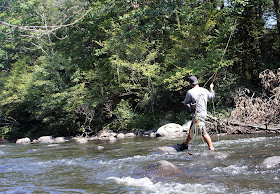It was Cole's first time witnessing the art of 'electrofishing' and I hadn't since 2010. If you've never been a spectator for this it's quite an experience, especially if you like to see how many trout actually live in a healthy river. When fishing blue-ribbon water like the Farmington, you're only observing a tiny fraction of the camouflaged trout right at your feet. Yet when the biologists turn on those generators and the electricity starts flowing, it's amazing at the amount of life you truly begin to see.
The fun part for us was when the wooden carts trailing behind were full of trout and the crews took a break from shocking to identify, measure and count them, as well as cherry-pick the best candidates for successful spawning back at the hatchery. Anyone who has spent a significant time on the Farmington has tied into one of her beautiful holdover or wild brown trout before, but to see this many all together is nothing short of awesome. It really underlines how lucky we are to have this wonderful resource in Connecticut and to have the caring folks in the Inland Fisheries Division watching over it.
While we only visited for a little while, the crews went at this for three straight days, wading miles of stream and sampling over 1,200 trout, which were made up of 92% brown trout, 7% rainbow trout, 1% brook trout! One of the highlights were the 193 young-of-year wild brown trout counted, which indicates that Farmington browns got off a great spawn last autumn despite the effects of Tropical Storm Irene. Also noteworthy was the abundance of slimy sculpins, which are an indicator fish of excellent water quality.

After a photo shoot and some politickin' with fisheries biologists, Cole and I downed sandwiches and headed upstream to find cooler water temperatures and a few willing trout. The water levels were extremely low due to the lack of rain and the fact they needed to be for sampling purposes. As beautiful as the setting was, the river just didn't look as appealing to me as she does in winter or springtime. I rarely target trout in the heat of summer or early fall, so I'll admit that I felt a little out of place.
Not far from the Goodwin Dam, we pulled over along a stretch of stream filled with fishy-looking pocket water. Cole and I opted to go small with three-weight fly rods and dropped tiny nymphs behind bushy dry flies. It was really cool to have a couple native brook trout smack our nymph patterns, especially when they made up just 1% of the entire sample a couple miles downstream. The bend in our rods rounded out a day well spent on the Farmington River and got me stoked for some colored-up brown trout in my net later this fall.
 |
| Cole hitting some pocket water with a classic bamboo rod. |










very cool, do those boxes they use for storage of the fish whilst they are stunned allow for river current to flow thru them, thereby oxygenating the water in the boxes ?
ReplyDeleteYes, Clint. The boxes are referred to as "Live Cars" and are essentially floating wood & wire live-wells that are towed around. The trout snap out of the shock 'daze' while inside these and are almost always returned safely.
ReplyDelete